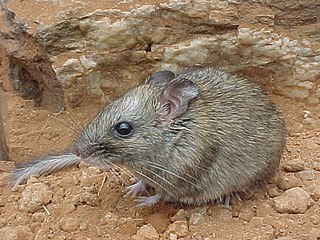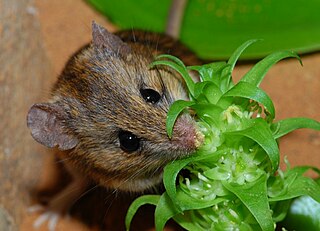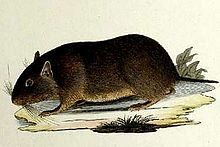
Zyzomys is a genus of rodents with unusually thick, long tails. Five species of the genus are known in Australia, where they are called rock rats or thick-tailed rats. The genus was classified by Michael Rogers Oldfield Thomas in 1909.

The Nesomyidae are a family of African rodents in the large and complex superfamily Muroidea. It includes several subfamilies, all of which are native to either continental Africa or to Madagascar. Included in this family are Malagasy rodents, climbing mice, African rock mice, swamp mice, pouched rats, and the white-tailed rat.

The Old World rats and mice, part of the subfamily Murinae in the family Muridae, comprise at least 519 species. Members of this subfamily are called murines. In terms of species richness, this subfamily is larger than all mammal families except the Cricetidae and Muridae, and is larger than all mammal orders except the bats and the remainder of the rodents.

Elaphe is a genus of snakes in the family Colubridae. Elaphe is one of the main genera of the rat snakes, which are found in many regions of the northern hemisphere. Elaphe species are medium to large constrictors by nature.

Aethomys is a genus of rodent from Africa. They are commonly referred to as rock rats, bush rats or rock mice.

Batomys is a genus of rodent endemic to the Philippines. It has six extant described species.

Tokudaia is a genus of murine rodent native to Japan. Known as Ryūkyū spiny rats or spinous country-rats, population groups exist on several non-contiguous islands. Despite differences in name and appearance, they are the closest living relatives of the Eurasian field mouse (Apodemus). Of the three species, both T. osimensis and T. tokunoshimensis have lost their Y chromosome and SRY gene; the sex chromosomes of T. muenninki, on the other hand, are abnormally large.
Grant's rock mouse or Grant's rock rat is a species of rodent in the family Muridae found only in South Africa. It is sometimes included in the genus Micaelamys. Its natural habitats are subtropical or tropical dry shrubland and rocky areas.
The Carpentarian rock rat is a species of rodent in the family Muridae. It is found only in Australia.

The central rock rat, also known as the central thick-tailed rock-rat, Macdonnell Range rock-rat, and Australian native mouse, is a critically endangered species of rodent in the family Muridae, endemic to Australia.

The Chilean rock rat is a species of rodent in the family Octodontidae. It is found in the high Andes of Argentina and Chile.

Octodontidae is a family of rodents, restricted to southwestern South America. Fourteen species of octodontid are recognised, arranged in seven genera. The best known species is the common degu, Octodon degus.

Arvicanthini is a tribe of muroid rodents in the subfamily Murinae. Almost all recent species in this tribe are or were found in Africa aside from one species, the Indian bush rat, which is found in South Asia and Iran. However, some fossil Golunda species from India and the genus Parapelomys are thought to have also occurred outside Africa, and one species in the fossil genus Saidomys may have also occurred in Afghanistan.










